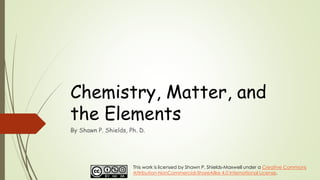
Matter and elements final
- 1. Chemistry, Matter, and the Elements By Shawn P. Shields, Ph. D. This work is licensed by Shawn P. Shields-Maxwell under a Creative Commons Attribution-NonCommercial-ShareAlike 4.0 International License.
- 2. Introduction to Chemistry Chemistry is the study of matter and energy
- 3. What is Matter? Matter is systematically ordered into two categories; mixtures versus pure substances. Each category is then divided into more detailed groupings. elements versus compounds heterogeneous versus homogeneous mixtures phases of matter
- 4. Pure Substances: Elements and Compounds Pure substances have distinct characteristics They can be elements or compounds Elements are composed of only one type of atom Elements are found on the periodic table Atoms are the smallest chemically distinct form of matter. We will discuss atoms in greater detail later in the course. Examples of elements are gold (Au), oxygen gas (O2) that we breathe, liquid nitrogen (N2), and helium (He)
- 5. Pure Substances- Compounds Compounds are formed when more than one type of element (or atom) bond together. Compounds have different types of atoms present in fixed proportions and have properties distinct from the elements from which they are formed, i.e., a “whole new substance”. There are a vast number of compounds (also called “chemicals”). Sucrose (C12H22O11) There are 12 carbon (C) atoms, 22 hydrogen (H) atoms, and 11 oxygen (O) atoms bonded together in every glucose molecule. Other everyday examples of compounds are Table salt (sodium chloride, NaCl) Water (H2O)
- 6. Mixtures versus Pure Substances Mixtures are formed between two or more pure substances. Each substance in the mixture retains its original characteristics, A mixture DOES NOT create a “whole new substance”. Examples of mixtures include syrup (sucrose (C12H22O11) in water) air (a mixture of mainly nitrogen (N2), oxygen (O2), plus a few other gases) milk cucumber and tomato salad
- 7. Heterogeneous vs Homogeneous Mixtures A homogeneous mixture is uniform throughout and you cannot visually separate the components Examples include “homogenized milk”, orange juice (no pulp), brewed coffee, and blood A heterogeneous mixture is one in which the components do not appear uniformly throughout the mixture Examples include fresh milk (with the cream floating on top), chicken noodle soup, a nut mixture, and orange juice with extra pulp
- 8. Phases of Matter The phases of matter fall into three main categories Gases, liquids, and solids Each phase has its own characteristic properties
- 9. Properties of the Phases of Matter Properties of gases (g) Have no definite shape (They take the shape of the container they are held in.) Gases do not have a specific volume (They fill all of the available volume.) Examples include steam, air, and oxygen gas (O2)
- 10. Properties of the Phases of Matter Properties of liquids (l) Have no definite shape (They take the shape of the container they are held in.) Liquids do have a specific volume Examples include water, canola oil, and vinegar
- 11. Properties of the Phases of Matter Properties of solids (s) Have a defined shape and volume Examples include ice, salt, wood, and granite
- 12. Mini Quiz Identify each substance as an element or compound Sodium chloride (NaCl) Neon gas (Ne) Liquid mercury (Hg) Alumina (Al2O3) Iodine crystals (I2)
- 13. Mini Quiz (Solutions) Sodium chloride (NaCl)- a compound because two types of atoms are bonded together. Neon gas (Ne)- an element because only one type of element is present in the substance. Liquid mercury (Hg)- an element because only one type of element is present in the substance. Alumina (Al2O3)- a compound because two types of atoms are bonded together. Iodine crystals (I2)- an element because only one type of element is present in the substance, even though two atoms are bonded together. Iodine is present as a diatomic (2-atom) molecule in its elemental form.
- 14. Mini Quiz Identify each substance as a pure substance or mixture Sodium chloride (NaCl) Diamond (made of carbon atoms bonded together) Cottage cheese Iron metal (Fe) soil A casserole
- 15. Mini Quiz Solutions Identify each substance as a pure substance or mixture Sodium chloride (NaCl)- chemical compounds are pure substances Diamond (made of carbon atoms bonded together)- elements are pure substances Cottage cheese- a mixture of cheese curds and whey Iron metal (Fe)- elements are pure substances Soil- a mixture of minerals and organic matter A casserole- possibilities are endless, but casseroles are always a mixture (e.g., potatoes, chicken, peas, gravy)
- 16. Mini Quiz Identify each mixture as heterogeneous or homogeneous Sodium chloride (NaCl) in water Veins of gold (Au) in rock Casserole Soapy water Water with ice cubes
- 17. Mini Quiz Solutions Sodium chloride (NaCl) in water- a homogeneous mixture, since the individual components are not observed separately Veins of gold (Au) in rock- a heterogeneous mixture, since the veins of gold are observed in separate areas on the rock Casserole- a heterogeneous mixture Soapy water- homogeneous mixture Water with ice cubes- heterogeneous mixture of phases
